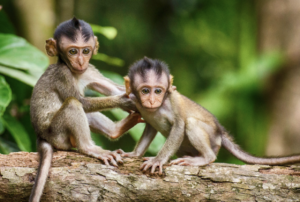The prevalence of intoxicated animals in the natural world is far greater than previously believed. This new discovery has sparked a human fascination with alcohol and its effects on different species.
A groundbreaking study published in Trends in Ecology & Evolution sheds light on the fact that many fruit-eating and nectar-sipping animals consume ethanol, a type of alcohol produced from fruit and grain sugars. Kimberley Hockings, a senior author and behavioral ecologist at the University of Exeter, highlighted the shift in perspective as researchers now realize that ethanol is not solely a human substance.
The history of ethanol consumption goes way back. Even dinosaurs like Tyrannosaurus rex had access to ethanol when fruit-bearing plants and vines emerged millions of years ago. As fallen fruit ferments, yeasts in the air and on the fruit’s surface convert sugar into ethanol, creating a beverage that resembles beer or wine.
In certain tropical regions like Panama, decaying palm fruit can reach alcohol levels exceeding 10 percent ABV, similar to wine. While most fruits contain low-proof alcohol levels ranging from 1 to 2 percent ABV, even this mild concentration can have intoxicating effects on birds and small mammals that consume them.
Matthew Carrigan, a professor of molecular ecology at the College of Central Florida, warns against intoxication in environments where predators lurk, stressing the importance of staying alert to pass on genes. The ability to metabolize ethanol without becoming inebriated is crucial for animals consuming these fermented fruits.
Contrary to humans who may seek intoxication without the excess calories, animals focus on energy intake rather than inebriation. They possess genetic adaptations that allow them to process ethanol efficiently, preventing intoxication. By exploiting the sweet aroma of fermenting fruit, animals can locate food sources without risking predation while intoxicated.
This fascinating discovery challenges the assumption that animals intentionally avoid intoxication. Recent research suggests that sentience and intelligence are more prevalent among animals than previously thought. The concept of communal drinking among social animals has been proposed, with potential cognitive benefits associated with ethanol consumption.
Anthropologists believe that social imbibing may have played a role in the development of early human societies. There may be advantages for social animals such as birds and certain mammals that outweigh the risks of intoxication. Understanding the effects of intoxication on animals compared to humans is essential to evaluate the potential benefits of communal drinking in wildlife.
Photographs of primates consuming intoxicating fruit, including chimpanzees and monkeys, have been shared by researchers to illustrate this behavior. Anna Bowland, a behavioral ecologist at the University of Exeter, suggests that ethanol consumption may have social advantages for certain species.
The activation of endorphins and dopamine systems by ethanol could lead to feelings of relaxation that benefit social interactions. More research is needed to determine the physiological responses to ethanol consumption in the wild, shedding light on the potential cognitive benefits for animals engaging in communal drinking.
Overall, the prevalence of alcohol consumption among animals opens up new avenues for research in ecology and biology. Understanding the relationship between ethanol intake, social behavior, and cognitive functions in wildlife can provide valuable insights into the evolutionary significance of alcohol in the natural world.




